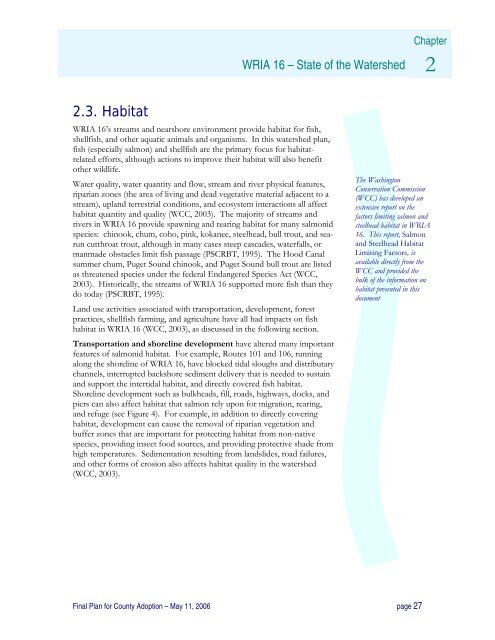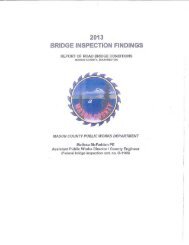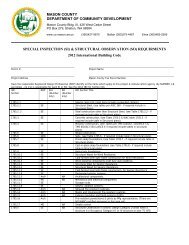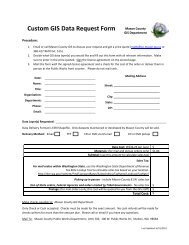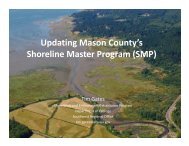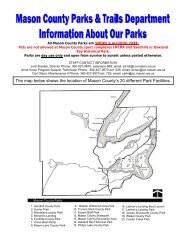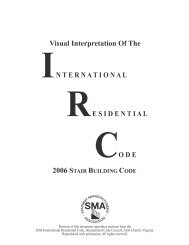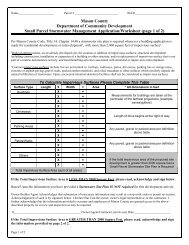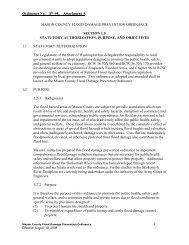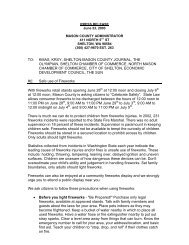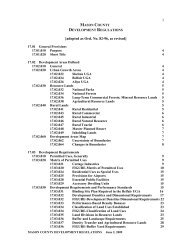Watershed Management Plan - Mason County
Watershed Management Plan - Mason County
Watershed Management Plan - Mason County
Create successful ePaper yourself
Turn your PDF publications into a flip-book with our unique Google optimized e-Paper software.
Chapter<br />
WRIA 16 – State of the <strong>Watershed</strong> 2<br />
2.3. Habitat<br />
WRIA 16’s streams and nearshore environment provide habitat for fish,<br />
shellfish, and other aquatic animals and organisms. In this watershed plan,<br />
fish (especially salmon) and shellfish are the primary focus for habitatrelated<br />
efforts, although actions to improve their habitat will also benefit<br />
other wildlife.<br />
Water quality, water quantity and flow, stream and river physical features,<br />
riparian zones (the area of living and dead vegetative material adjacent to a<br />
stream), upland terrestrial conditions, and ecosystem interactions all affect<br />
habitat quantity and quality (WCC, 2003). The majority of streams and<br />
rivers in WRIA 16 provide spawning and rearing habitat for many salmonid<br />
species: chinook, chum, coho, pink, kokanee, steelhead, bull trout, and searun<br />
cutthroat trout, although in many cases steep cascades, waterfalls, or<br />
manmade obstacles limit fish passage (PSCRBT, 1995). The Hood Canal<br />
summer chum, Puget Sound chinook, and Puget Sound bull trout are listed<br />
as threatened species under the federal Endangered Species Act (WCC,<br />
2003). Historically, the streams of WRIA 16 supported more fish than they<br />
do today (PSCRBT, 1995).<br />
Land use activities associated with transportation, development, forest<br />
practices, shellfish farming, and agriculture have all had impacts on fish<br />
habitat in WRIA 16 (WCC, 2003), as discussed in the following section.<br />
Transportation and shoreline development have altered many important<br />
features of salmonid habitat. For example, Routes 101 and 106, running<br />
along the shoreline of WRIA 16, have blocked tidal sloughs and distributary<br />
channels, interrupted backshore sediment delivery that is needed to sustain<br />
and support the intertidal habitat, and directly covered fish habitat.<br />
Shoreline development such as bulkheads, fill, roads, highways, docks, and<br />
piers can also affect habitat that salmon rely upon for migration, rearing,<br />
and refuge (see Figure 4). For example, in addition to directly covering<br />
habitat, development can cause the removal of riparian vegetation and<br />
buffer zones that are important for protecting habitat from non-native<br />
species, providing insect food sources, and providing protective shade from<br />
high temperatures. Sedimentation resulting from landslides, road failures,<br />
and other forms of erosion also affects habitat quality in the watershed<br />
(WCC, 2003).<br />
The Washington<br />
Conservation Commission<br />
(WCC) has developed an<br />
extensive report on the<br />
factors limiting salmon and<br />
steelhead habitat in WRIA<br />
16. This report, Salmon<br />
and Steelhead Habitat<br />
Limiting Factors, is<br />
available directly from the<br />
WCC and provided the<br />
bulk of the information on<br />
habitat presented in this<br />
document<br />
Final <strong>Plan</strong> for <strong>County</strong> Adoption – May 11, 2006 page 27


